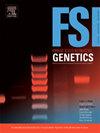评估用于巴西混血儿人种识别的多重 InDel 面板的性能
IF 3.2
2区 医学
Q2 GENETICS & HEREDITY
引用次数: 0
摘要
插入/缺失多态性或 InDels 广泛存在于人类基因组中。由于它们可以使用 CE 平台和法医实验室使用的兼容分型技术进行基因分型,因此被认为是法医分析的潜在标记物。此外,InDels 的突变率较低,扩增片段通常较短,因此非常适合检测降解样本。然而,大多数 InDels 都是双等位基因,因此鉴别能力相对较低。为了提高 InDel 的信息量,一种新的遗传标记被称为多重 InDel。多重 InDel 标记一般被称为在短距离(通常小于 200 bp)内包含两个或多个 InDel 的微单倍型。在这项研究中,我们评估了之前提出的三个针对亚洲人群设计的多 InDel 标记组在巴西人类鉴定中的适用性。我们利用居住在巴西最大城市圣保罗的 1171 名巴西人的人口普查队列中的高覆盖全基因组测序数据,对所有多重 InDel 标记进行了评估。结果表明,大多数标记对巴西人都有参考价值,因为它们呈现出三种以上不同大小的频繁单倍型。然而,由于存在重复或低复杂性区域,大多数标记容易出现扩增/测序错误。在测试过的面板中,Huang 等人(2014 年)的面板最有希望用于巴西的法医鉴定,其综合匹配概率和累积排除能力分别为 4.92 ×10-14 和 0.9991。然而,与 CODIS STRs(短串联重复序列)和更大的 SNP(单核苷酸多态性)面板相比,这些数值较低。因此,仍有必要进行新的尝试,在人类基因组中扫描高多态性的多重 InDel 标记,以获得适合全球人群的多重 InDel 面板。本文章由计算机程序翻译,如有差异,请以英文原文为准。
Assessing the performance of multi-InDel panels for human identification among admixed Brazilians
Insertion/deletion polymorphisms, or InDels, are widely present in the human genome. They have been considered as potential markers for forensic analysis because they can be genotyped using the CE platform and compatible typing techniques used in forensic laboratories. Additionally, InDels have lower mutation rates and often short amplicon sizes, making them ideal for detecting degraded samples. However, most InDels are bi-allelic; therefore, their discrimination power is relatively low. A new set of genetic marker called multi-InDels was reported to improve InDel's informativeness. Multi-InDel markers are generally designated as microhaplotypes encompassing two or more InDels within a short distance, usually less than 200 bp. In this study, we evaluated the applicability of three previously proposed panels of multi-InDel markers, designed for Asian populations, for human identification in Brazil. We assessed all the multi-InDel markers using high-coverage whole-genome sequencing data from a census-based cohort of 1171 Brazilians residing in São Paulo, the largest Brazilian capital. The results showed that most markers are informative for Brazilian individuals since they present more than three frequent haplotypes with different sizes. However, most markers are prone to amplification/sequencing errors due to repetitive or low-complexity regions. Among the tested panels, the one from Huang et al. (2014) is the most promising for forensic use in Brazil, with a combined match probability and cumulative power of exclusion of 4.92 ×10−14 and 0.9991, respectively. Nevertheless, these values are low compared to the ones obtained with CODIS STRs (short tandem repeats) and larger SNP (single nucleotide polymorphisms) panels. Therefore, new attempts to scan the human genome for highly polymorphic multi-InDel markers are still necessary to obtain a suitable panel of multi-InDels for worldwide populations.
求助全文
通过发布文献求助,成功后即可免费获取论文全文。
去求助
来源期刊
CiteScore
7.50
自引率
32.30%
发文量
132
审稿时长
11.3 weeks
期刊介绍:
Forensic Science International: Genetics is the premier journal in the field of Forensic Genetics. This branch of Forensic Science can be defined as the application of genetics to human and non-human material (in the sense of a science with the purpose of studying inherited characteristics for the analysis of inter- and intra-specific variations in populations) for the resolution of legal conflicts.
The scope of the journal includes:
Forensic applications of human polymorphism.
Testing of paternity and other family relationships, immigration cases, typing of biological stains and tissues from criminal casework, identification of human remains by DNA testing methodologies.
Description of human polymorphisms of forensic interest, with special interest in DNA polymorphisms.
Autosomal DNA polymorphisms, mini- and microsatellites (or short tandem repeats, STRs), single nucleotide polymorphisms (SNPs), X and Y chromosome polymorphisms, mtDNA polymorphisms, and any other type of DNA variation with potential forensic applications.
Non-human DNA polymorphisms for crime scene investigation.
Population genetics of human polymorphisms of forensic interest.
Population data, especially from DNA polymorphisms of interest for the solution of forensic problems.
DNA typing methodologies and strategies.
Biostatistical methods in forensic genetics.
Evaluation of DNA evidence in forensic problems (such as paternity or immigration cases, criminal casework, identification), classical and new statistical approaches.
Standards in forensic genetics.
Recommendations of regulatory bodies concerning methods, markers, interpretation or strategies or proposals for procedural or technical standards.
Quality control.
Quality control and quality assurance strategies, proficiency testing for DNA typing methodologies.
Criminal DNA databases.
Technical, legal and statistical issues.
General ethical and legal issues related to forensic genetics.

 求助内容:
求助内容: 应助结果提醒方式:
应助结果提醒方式:


